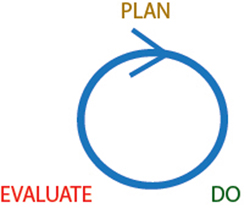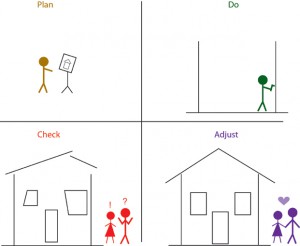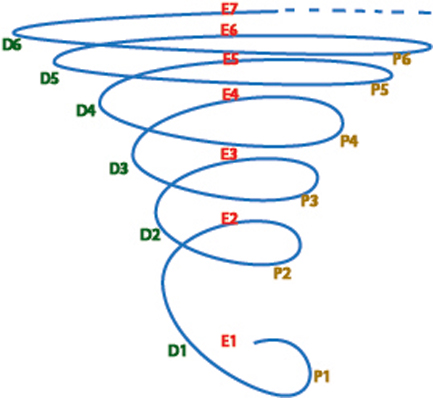Strategic Continuous Process Improvement
There are a couple of insights that can be gleaned from rewriting the Plan – Do – Check – Adjust (PDCA) cycle in a different manner. Although the check and adjust steps are necessary, for the purposes of the next illustration they can be combined into a step called “evaluate” so that the improvement cycle looks like the clockwise circle with a “PDE” arranged around it.

This arrangement implies that planning is the first step in this cycle and that evaluating is merely a check-the-box step. Obviously, this makes no sense. There is no point in evaluating something that you are not going to improve in some manner.
Including the “Evaluate” step makes more sense when viewed in the manner of a PDE Tornado-like-Ascending-Helix (See Helix article), so that the cycles are stacked on top of each other in rapid-execution style. When stacked one upon another like this, the “evaluate” step becomes the link between each successive iteration.

However, “Evaluate” is much more than an after-the-fact action. Consider your perspective from the “Plan” step of the first cycle of a tornado. Ask yourself the question, “Why are we focusing organizational resources on this particular project?” Hopefully, you have identified this project as critical to improving throughput in your organization by some combination of increasing your throughput’s quantity or quality, or alternately, by decreasing its risk or hassle. If the project you are presently “Planning” will not accomplish this better than alternative uses of the required project resources, perhaps it would be better to “Evaluate” it to a lower priority in favor of a project that WILL accomplish improving throughput in your organization.
Throughput is the means to achieving your organization’s purpose for existence: no sales/deliveries… no financial profit; no successful peace negotiation… no immediate greater peace for mankind; no successful surgical procedures… no “greater quality of life”, and so on. “Throughput” in this case refers to what your organization does that justifies the attention of your final consumers (customers, clients, patients, or citizens) so you CAN achieve your organization’s purpose for existence. (Note that identifying the customers of your process, and what they each want, is oftentimes very enlightening. Please see the Customer Identification in Intellectual Property processing section in the Legal Lean article.)
Also, regarding throughput, the Theory of Constraints asserts that increasing usable process throughput occurs ONLY by increasing the usable capacity of the single, systemic, bottleneck-resource constraint. (Very occasionally, two process resources alternate as the very short term process constraint. However, this is quite rare. At any given moment, there is usually just one process constraint.) However, before you can increase throughput by increasing the usable capacity of the system constraint, you must clearly identify the system constraint. (Please see the Chiropractic School of Lean Implementation article.)
Proposal: instead of placing the “Evaluate” step at the end of the improvement cycle, consider re-portraying the rapidly repeating cycle as “Evaluate”, “Plan”, and “Do” (EPD) and then stack 4 to 6 iterations on top of each other in rapidly iterating cycles as an EPD Tornado!

The root idea is that “Evaluate” is the strategic step of this cycle, whereas “Plan” is the tactical step, or in other words, how you will actually accomplish the strategic objective for this particular improvement cycle, and “Do” is the execution step. Hence, each cycle has strategic components, tactical components, and execution components. The entire “Tornado-like” Helix terminates when the “Evaluate” (strategic) step determines that the resources being expended on this improvement project would be better expended on a now larger impediment to overall systemic flow within the organization. Or, in other words… after running 4 to 6 sequential projects… there is a bigger “rock” (impediment to overall organizational “flow”) in the “sluice.” (See the Sluice Analogy article for the relationship between the Sluice and the Helix.)
